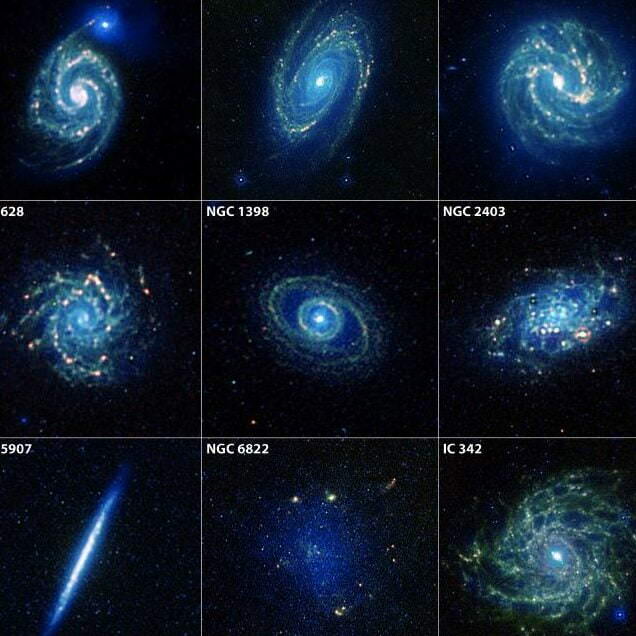A galaxy is an enormous system of stars, planets, gas, and dust that are held together by gravity. Our solar system, for instance, is a part of the Milky Way galaxy, which is believed to contain over 100 billion other stars. Overall, scientists estimate that there are more than two trillion galaxies in the universe. However, most galaxies can be categorized into specific types and have either a spiral shape, like the Milky Way, or an elliptical or irregular shape. Nevertheless, in the vast expanse of the infinite Universe, there exist galaxies that defy classification. While some peculiar and extraordinary galaxies are the result of gravitational interactions with other larger or sometimes smaller objects, they share a common trait: they resemble more of an artist’s imagination than actual, tangible collections of billions of stars. Allow us to introduce you to the most peculiar galaxies currently known to humanity.
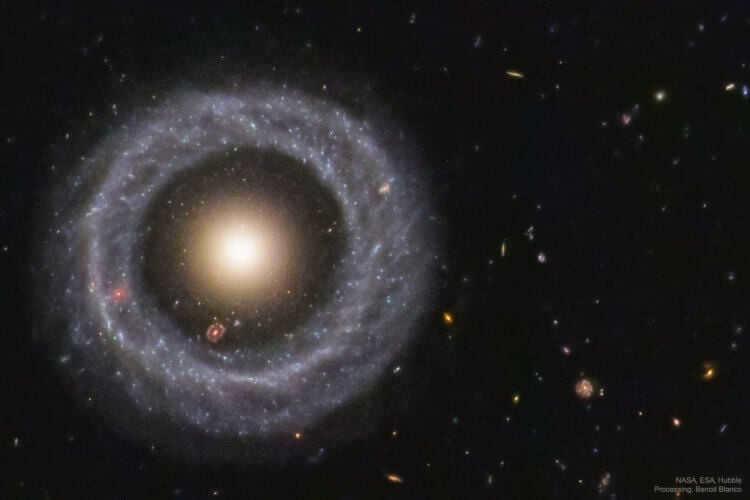

As of now, there are only a few known ring galaxies like Hog’s Object, which can be found in the Serpent constellation and are positioned approximately 600 light years away from our planet. This unique galaxy was first detected in 1950 by Arthur Hoge, an American astronomer.
Edwin Hubble’s Classification of Galaxies
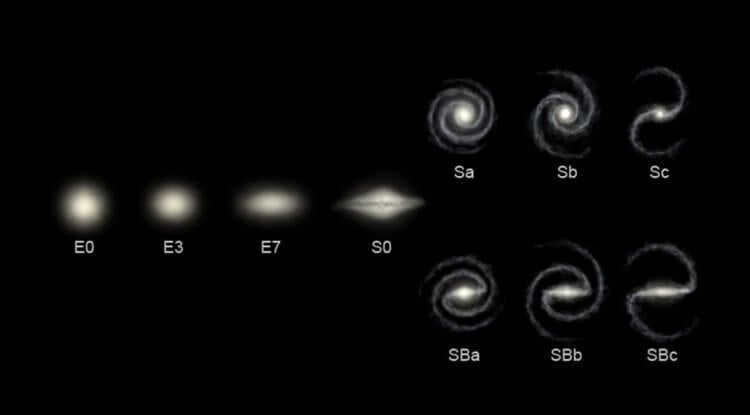
Astronomer Edwin Hubble created a classification system for galaxies during the 20th century.
When trying to understand various phenomena, it is often helpful to classify them. In the 1920s, Edwin Hubble, a renowned astronomer, examined a large collection of galaxy images and categorized them based on their characteristics. Hubble’s classification system divides galaxies into three main types: elliptical, spiral, and irregular. Today, astronomers continue to use Hubble’s system to accurately study individual galaxies.
The Black Eye Galaxy (M64) is also known as The Black Eye Galaxy. It belongs to the category of Spiral Galaxies and can be found in the constellation of Veronica’s Hair.
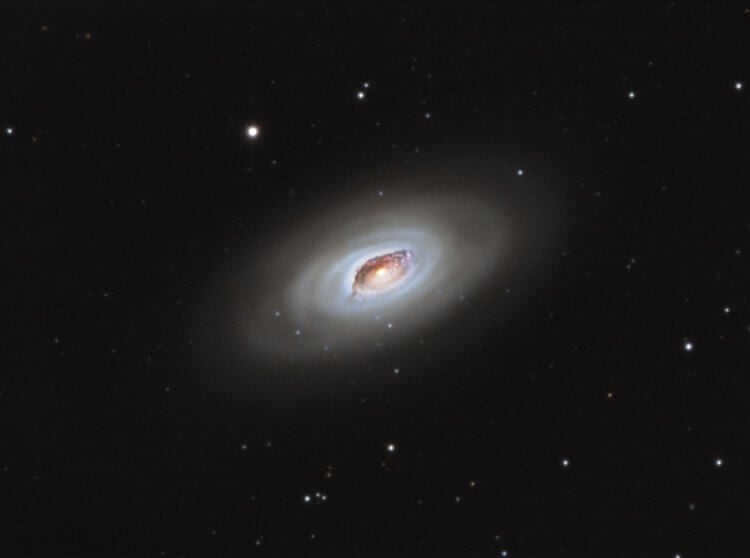

M64 can be found 17 million light-years away from Earth in the constellation Veronica’s Hair.
Despite the multitude of vibrant and colorful galaxies in the Universe, M64 stands out, reminiscent of the vibrant covers of science fiction magazines from the 1950s. This galaxy exhibits a high rate of star formation, as evidenced by the red light in the Hubble Space Telescope image above. However, what is truly peculiar is that M64 is the result of the merger of two galaxies with opposite rotation directions. The inner part of the system rotates in one direction, while the stars and dust in the outer regions (approximately 40,000 light-years away) rotate in the opposite direction.
Messier 64’s distinctive dark formation is a notable dusty characteristic of the galaxy, concealing the stars beyond.
The Southern Wheel Galaxy (M83)
The Southern Pinwheel Galaxy (also known as the Southern Pinwheel).
Classification: Barred Spiral Galaxy.
Located in the constellation Hydra.
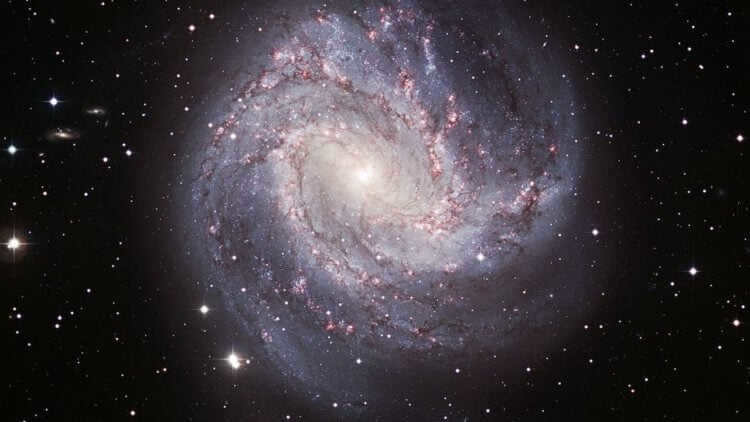
The Southern Pinwheel Galaxy is located at a distance of about 15 million light years from our position.
Sombrero Galaxy (M104).
The Sombrero Galaxy is classified as a spiral galaxy that lacks a bar in its center. It can be found in the constellation Virgo.
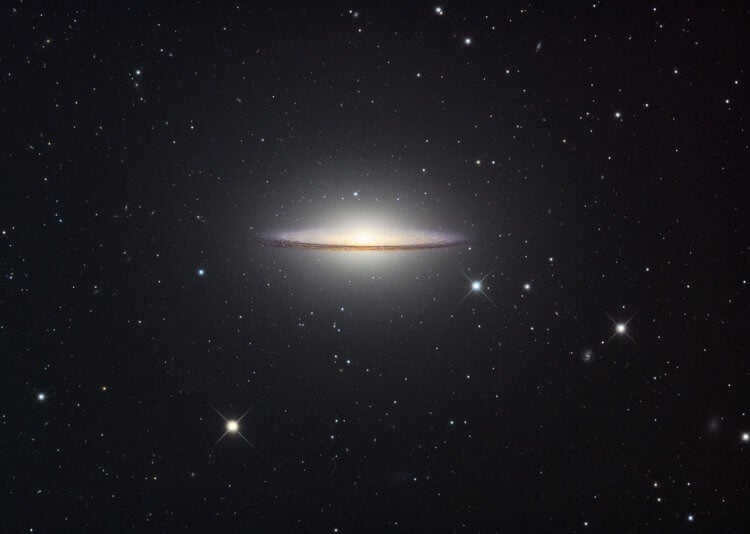

The Sombrero Galaxy is positioned 29.3 million light-years away from the Sun. According to the findings from the Spitzer telescope, M104 is composed of two separate galaxies: a flat spiral galaxy is encompassed within an elliptical galaxy.
Discovered in 1781, the Sombrero galaxy earned its name due to its distinct center and band of dark dusty matter. Typically, a galaxy’s center or nucleus is composed of a singular, uniform collection of stars. However, in the case of M104, the nucleus is comprised of multiple distinct clusters of stars, although this may not be readily apparent in visible light. For many years, astronomers struggled to explain the presence of a streak of dust surrounding the core. This changed in February 2020, when a team of astronomers, led by Paul Goudfrooij, analyzed data from observations made by the Hubble Space Telescope. The findings revealed that the galaxy M104 formed as a result of a powerful collision between large galaxies. The scientists reached this conclusion by measuring the metallicity of the halo stars, which are located far from the galaxy’s center and disk.
Centaurus A Galaxy (NGC 5128)
The galaxy known as Centaurus A (or NGC 5128) is classified as an elliptical galaxy and is located in the constellation Centaurus.
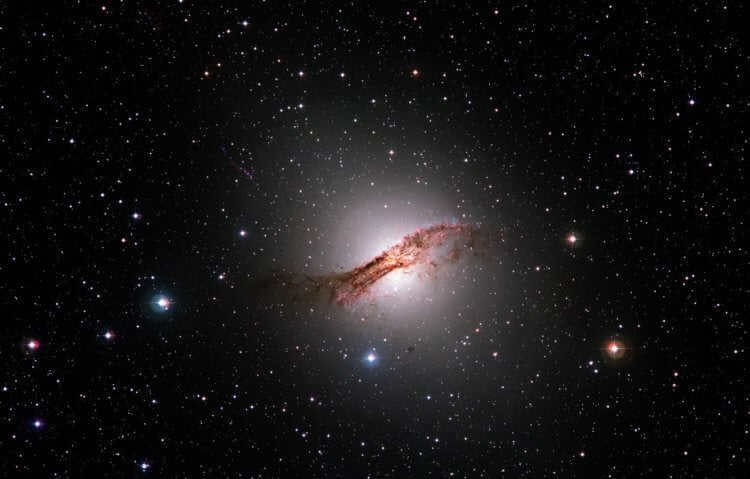

Centaurus A is among the nearest galaxies to our location, positioned 12 million light years away.
The galaxy known as Centaurus A is quite remarkable, as depicted in the photograph provided. In the realm of optical light, NGC 5128 presents itself as a vast elliptical galaxy. However, what truly sets it apart is the revelation of an inconspicuous spiral when observed at higher frequencies. The prevailing belief is that this spiral component represents the remnants of a once independent spiral galaxy that was assimilated by a larger and more massive elliptical galaxy in the distant past. It is, however, highly improbable that such an interaction would have left the spiral formation intact or even recognizable. Nevertheless, the aforementioned image undeniably showcases the remarkably preserved spiral structure of NGC 5128.
The galaxy NGC474 is classified as an elliptical galaxy and is located in the constellation Pisces.
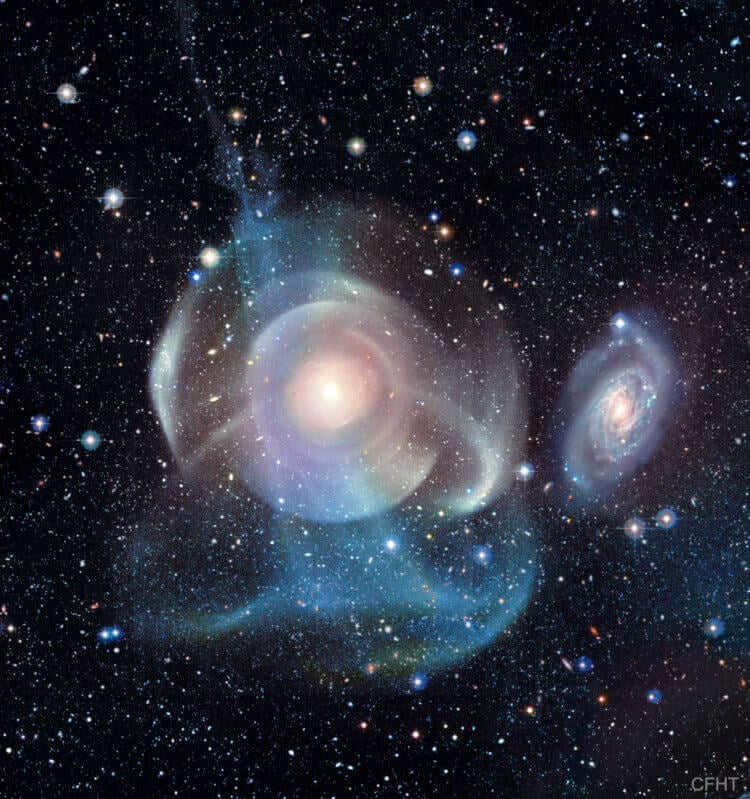
This galaxy, NGC474, was found by William Herschel in 1784. Its surprisingly intricate structure is revealed by the presence of multiple luminous shells.
If the appearance of the South Wheel Galaxy aligns with the expected characteristics of active galaxies, then NGC474 is a prime example of what elliptical galaxies should not resemble. The image presented here is not a mere depiction conjured from the pages of a science fiction novel, but rather a genuine galaxy that is undergoing a process of fragmentation due to the gravitational forces exerted upon it by the spiral galaxy situated behind and above it. Nevertheless, it is the presence of sparsely distributed gas and dust shells that bestow upon this galaxy the semblance of a jellyfish, and it is known that many, if not most, galaxies possess similar gas shells. Scientists posit that these shells are a direct consequence of past galactic collisions, at least in the context of cosmic time.
Irregular galaxies, as the name suggests, represent a varied array of cosmic structures that do not conform to the established Hubble sequence.
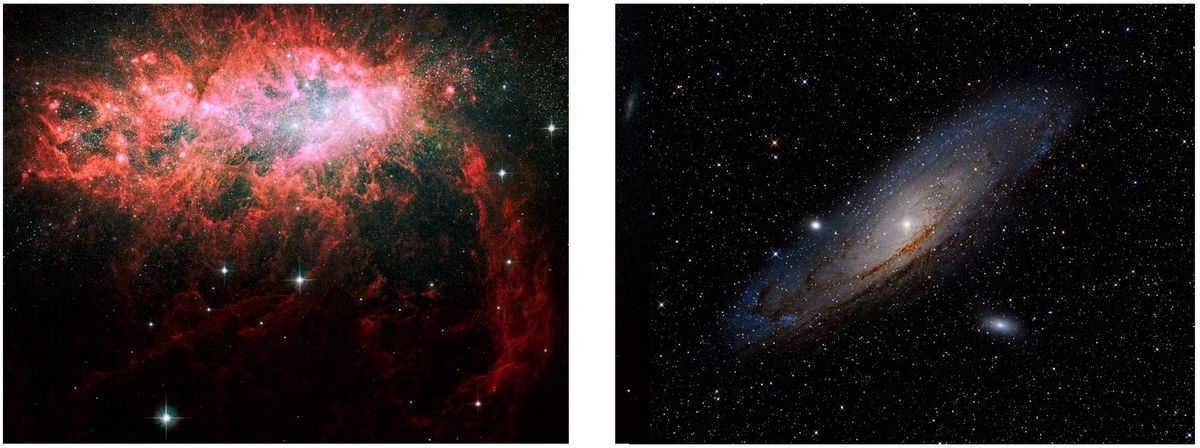
NGC 1569, an irregular galaxy, is displayed on the left side, while M31, a spiral galaxy, is shown on the right side. Just like the classic game, spot the differences between these two!
Irregular galaxies account for approximately 25% of all galaxies in the Universe. Interestingly, some irregular galaxies were once spiral or elliptical in shape before being distorted by the gravitational pull of neighboring galaxies.
These irregular galaxies tend to be relatively small, with diameters ranging from 1.5 to 3 kpc, and they possess moderate to low luminosity. The largest among them barely reaches 1/10th of the Milky Way’s mass. Due to their compact size, they are more vulnerable to environmental influences such as collisions with larger galaxies and intergalactic clouds of cosmic dust.
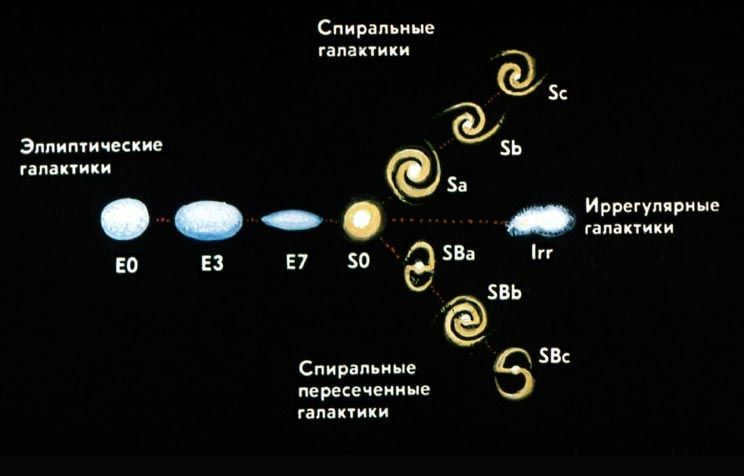

A simplified system for classifying galaxies, known as the Hubble classification scheme, includes a category for irregular galaxies (Irr) which do not fit into any other category.
Types and Categories of Irregular Galaxies
Although irregular galaxies differ greatly from one another, the following classification is used to describe them:
- Irr I (type I irregular galaxies) – galaxies that exhibit a faint structure, but it is too faint to be classified within the Hubble sequence. However, type I irregular galaxies can be further classified into two subtypes:
Sm – characterized by a spiral structure (also known as Magellanic spiral galaxies);
Im – lacking a spiral structure. - Irr II (Irregular galaxies of type II) – galaxies that lack any discernible structural features that would place them within the Hubble sequence;
- dIrr (dwarf irregular galaxies) – These are extremely small galaxies that have a low concentration of heavy elements and a significant amount of gas. They are highly significant in the study of galaxy evolution theory as they could potentially be the faint blue galaxies that were previously identified in the Hubble Ultra Deep Field image. Furthermore, they present a significant challenge in the field of extragalactic astronomy.
The constellation Peacock is home to the distant irregular galaxy IC 4710, which is located about 34 million light-years away. This fascinating galaxy is composed of brilliant stars and is currently undergoing active star formation processes. With a diameter of approximately 36,000 light-years, IC 4710 is a captivating sight in the night sky.
IC 4710 is classified as a dwarf irregular galaxy of Irr I type. Unlike spiral galaxies, it lacks a prominent nucleus and spiral arms, giving it the appearance of a massive sphere filled with stars arranged in chaotic patterns. Delilah Stewart made the remarkable discovery of this galaxy on August 18, 1900.
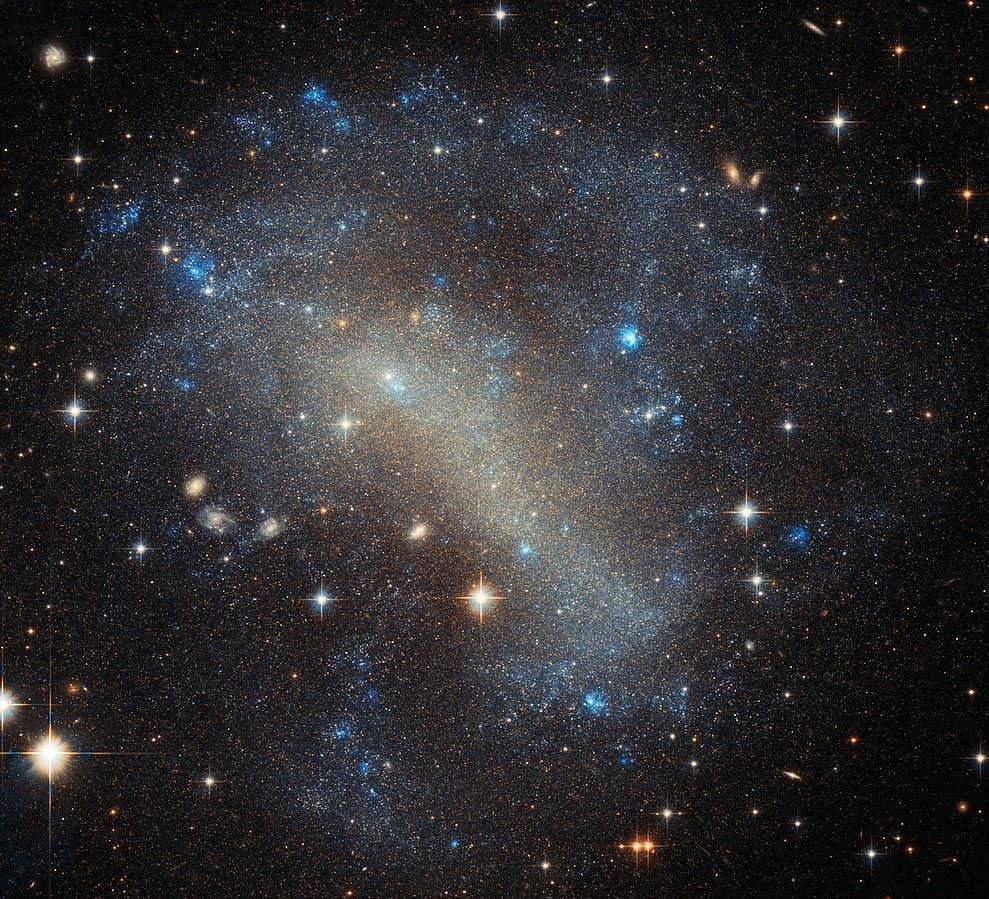
The Peacock constellation is home to the irregular galaxy IC 4710.
IC 4710, an irregular galaxy, can be found about 30 million light-years away in the Virgo constellation. While it may not initially appear to have a clear structure, a closer look reveals a noticeable concentration of stars near its center. This galaxy likely experienced a similar fate to our Magellanic clouds, as it was once a spiral galaxy but was eventually crushed by the gravitational pull of one of its larger neighbors, such as M90. Isaac Roberts discovered IC 4710 on April 29, 1892.
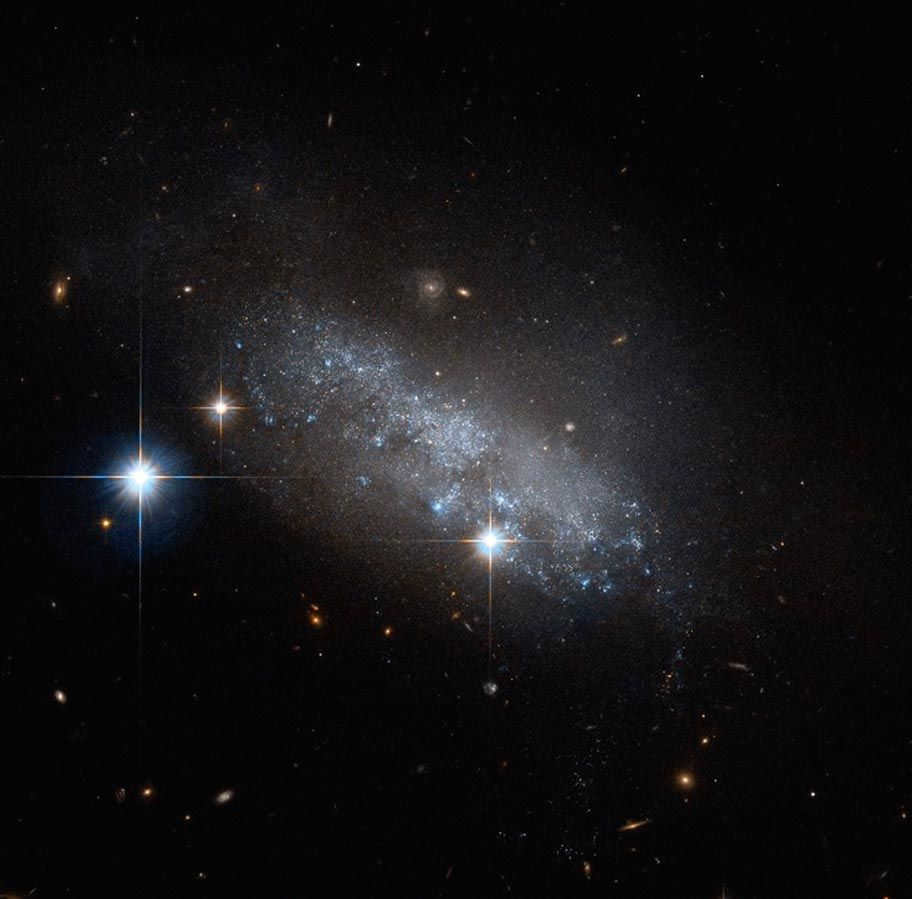
The irregular galaxy IC 3583 can be found in the constellation Virgo.
ESO 338-4, also known as the blue dwarf galaxy, is another example of an irregular galaxy. However, it differs from IC 4710 and IC 3583 in terms of its characteristics. Recently, it underwent a merger with a smaller galaxy, resulting in a burst of star formation and significant disruption in its structure. The newly formed massive stars, responsible for the galaxy’s blue glow, have a short lifespan of a few million years before depleting their hydrogen fuel reserves. Over time, as the effects of the merger subside and the turbulent processes within the galaxy settle, ESO 338-4 may eventually adopt a more conventional form.
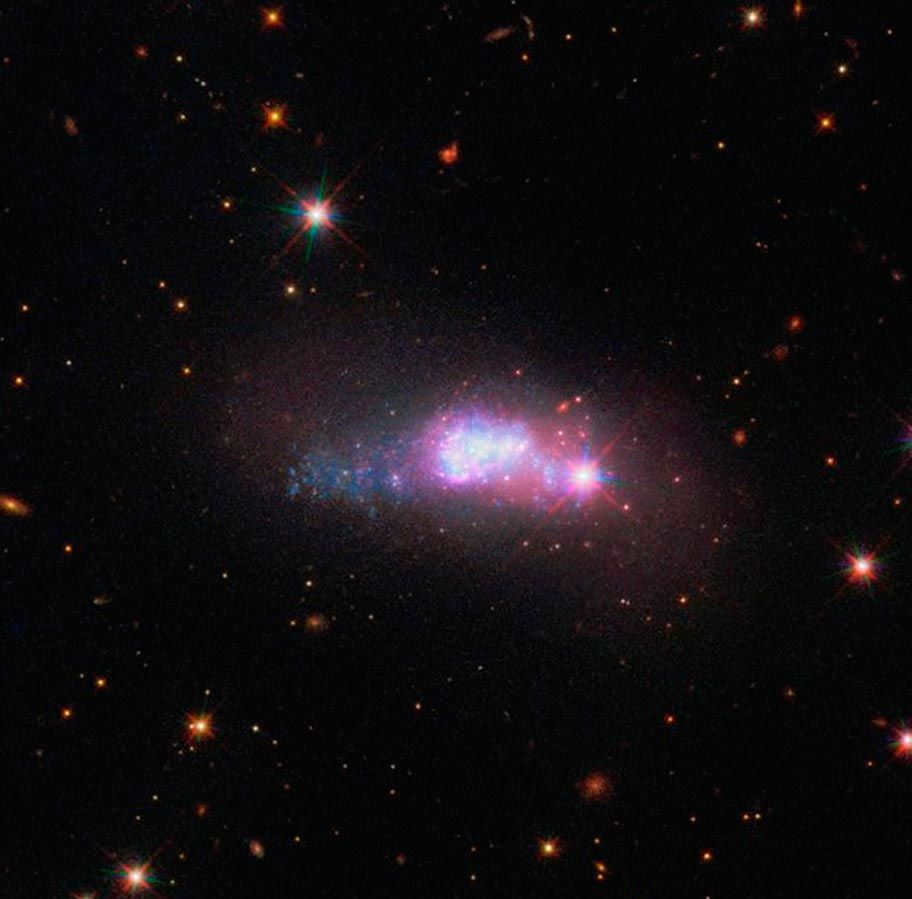
ESO 338-4, a galaxy characterized by its blue dwarf appearance
Magellanic clouds are not irregular galaxies!
The Magellanic Clouds (Large and Small) are the nearest satellites of our Galaxy. They can be found in the Southern Hemisphere of the sky within the constellation Goldfish. These celestial bodies were initially documented by Antonio Francesco Pigafetta, a participant in Magellan’s circumnavigation of the world, and were thus named after him.
Due to their close proximity, both the Large Magellanic Cloud and the Small Magellanic Cloud, along with our own Galaxy, form a unique triple galactic system. These galaxies are not only connected to each other, but also appear to be connected to our Galaxy through a bridge of gas. The distance between the Large Magellanic Cloud and our Galaxy is 52 kiloparsecs, while the distance between the Small Magellanic Cloud and our Galaxy is 63 kiloparsecs. The Large Magellanic Cloud spans a length of 12 kiloparsecs, while the Small Magellanic Cloud spans a length of 4 kiloparsecs. The velocities of these galaxies relative to the center of our Galaxy are +40 km/sec for the Large Magellanic Cloud and -15 km/sec for the Small Magellanic Cloud. Additionally, the mass of the Large Magellanic Cloud, as determined by its rotation, is 15 times smaller than the mass of our Milky Way.
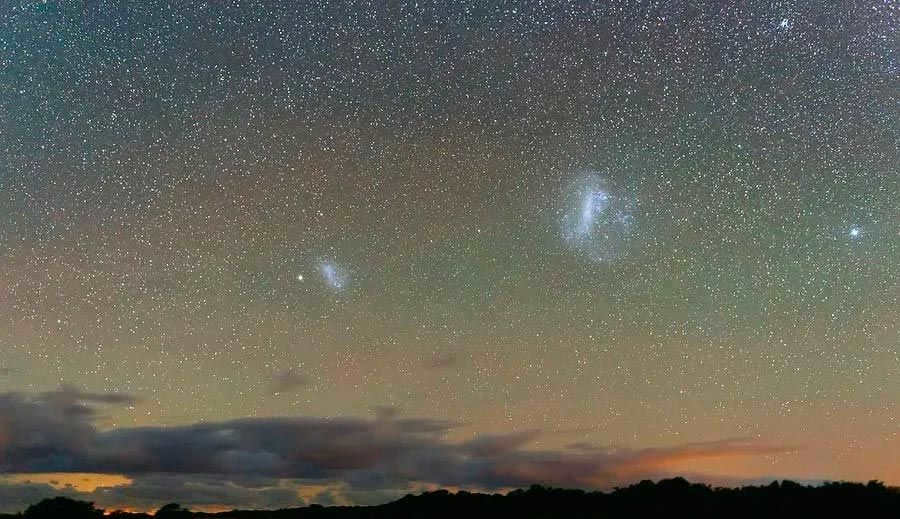
Large and small Magellanic clouds can be seen in the southern sky. These clouds used to be considered as examples of “wrong galaxies,” but further research has provided more clarity:
- The Small Magellanic Cloud is classified as an irregular type I dwarf galaxy. It is believed that it may have had a spiral shape in the past, but due to the gravitational forces of the Milky Way, it lost its original shape.
- The Large Magellanic Cloud, on the other hand, has faced a similar fate as the small cloud. However, due to its larger size, it has managed to retain more of its original shape. Therefore, it can still be categorized as a type IV spiral galaxy in the Hubble sequence (SB(s)m).
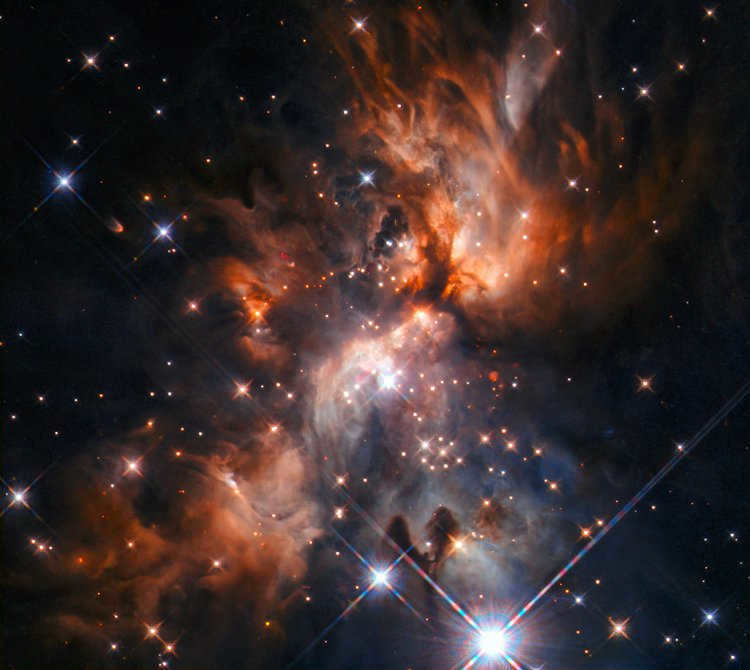
The discovery of the celestial object known as IC 2431 dates back to February 24, 1896 when it was first observed by Stéphane Javel, an astronomer from France. Situated approximately 681 million light-years away from our planet, this cosmic phenomenon has recently been documented by the Hubble Space Telescope. The images obtained showcase a mesmerizing triple galaxy merger unfolding before our eyes, accompanied by a dynamic blend of stellar birth and gravitational disturbances resulting from the interplay between these three galaxies.
The dense cloud of dust obscures the central part of the picture, but the light coming from the distant galaxy can still be seen shining through its outer edges. This image was created using data collected in the infrared, optical, and ultraviolet spectrums, using the Advanced Camera for Surveys Hubble (ACS), the Dark Energy Camera (DECam) on the Victor M. Blanco 4-meter telescope, and the Sloan Digital Sky Survey (SDSS). To capture a variety of wavelengths, nine different filters were utilized. By assigning distinct colors to each monochrome image obtained from a specific filter, a vibrant and visually appealing final result was achieved.
The galaxy with a “smirking” expression
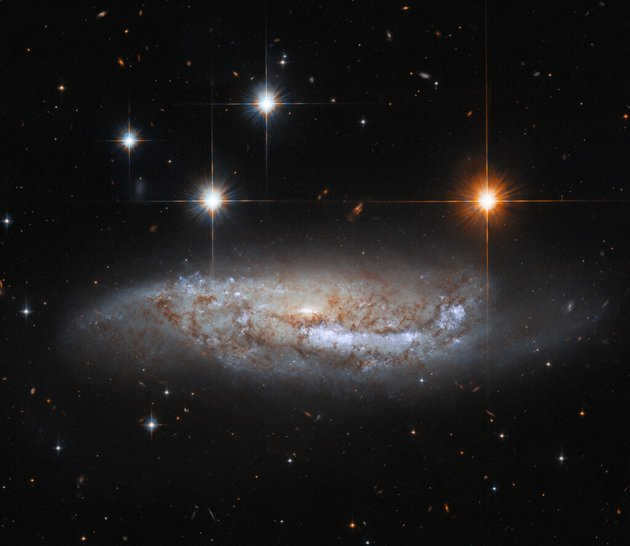
A group of amateur astronomers based in New Zealand first observed a sudden burst of light emanating from the Centaurus constellation back in 2014. Subsequently, NASA confirmed that the burst was, in fact, a colossal supernova explosion occurring in a distant galaxy. Remarkably, this particular galaxy was situated an astounding distance of 57 million light-years away from our very own Milky Way.
Fast forward to 2021, and the Hubble Space Telescope once again trained its gaze upon the aforementioned galaxy. The resultant image showcases the mesmerizing sights of NGC 3568, with its ethereal gas clouds and sparkling stars seemingly bubbling away in the vast expanse of space, juxtaposed against the much closer and significantly brighter stars belonging to our own Galaxy.
“Eerie visage from the cosmos.”
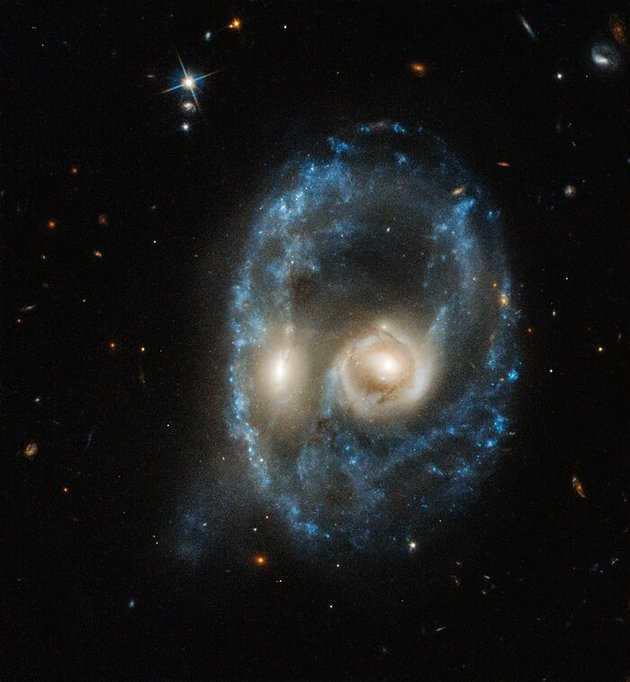
The photograph was captured during the lead-up to Halloween in 2019 and showcases a macabre-looking colossal head in space. However, disregarding any thoughts of sinister forces roaming free before All Saints’ Day, the picture easily identifies two galaxies in the midst of merging.
This particular galaxy system is known as Arp-Madore 2026-424. It is situated 704 million light-years away from Earth and possesses an atypical shape caused by the turbulent effects resulting from the collision. Astronomers Halton Arp and Barry Madore initially discovered this system in 1987, classifying it as a ring galaxy.
An active nucleus is present in a galaxy with remarkable activity
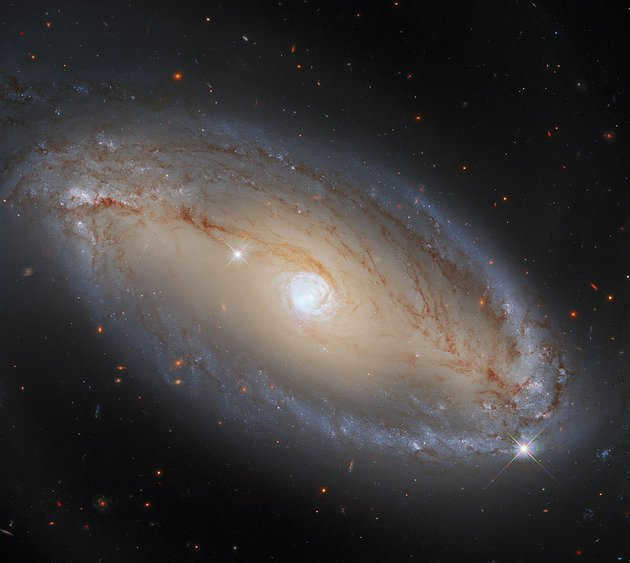
NGC 5728, a spiral galaxy located in the constellation Libra, was captured by the Hubble telescope in 2021. Situated 130 million light-years away from Earth, this galaxy stands out due to its active nucleus. Classified as a Seyfert galaxy, NGC 5728 is characterized by its spiral or irregular shape and its active nucleus (AGN). Its emission spectrum features bright broad bands, indicating the presence of powerful gas emissions with velocities reaching several thousand kilometers per second.
There are various types of AGNs, but Seyfert galaxies are distinct from others in that the galaxy itself is clearly visible. Galaxies with other AGNs, like quasars, are nearly impossible to observe due to their incredibly strong radiation.
A distant galaxy witnesses the creation of a colossal star in its core
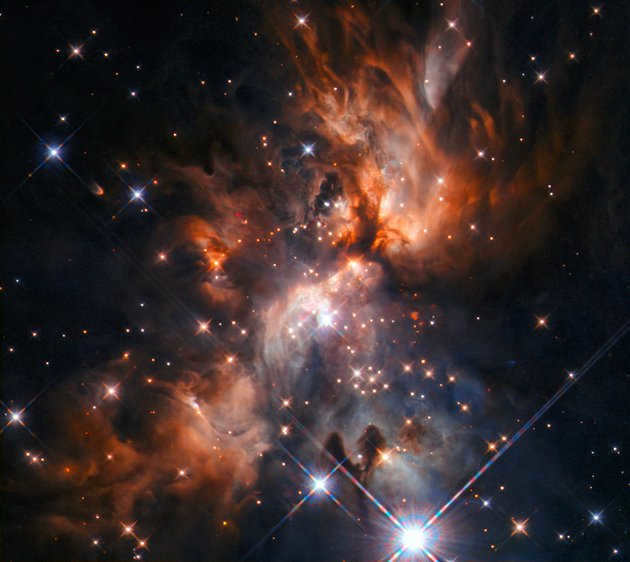
This particular star nursery is situated in the constellation Gemini and is approximately 50 light-years away. It has been officially designated as AFGL 5180. Among the many regions where stars are formed, this one possesses the optimal combination of dust and gas density required for the eventual collapse of this material into stars.
Within the Hubble image, a massive star is currently being formed at the center, and the dust clouds are being illuminated by beams of light.
“The majority of the light emitted by this star escapes and reaches us, causing these cavities to be illuminated like a beacon piercing through storm clouds,” NASA stated.
Deep Space: Exploring the Ultimate Phase of Galaxy Mergers
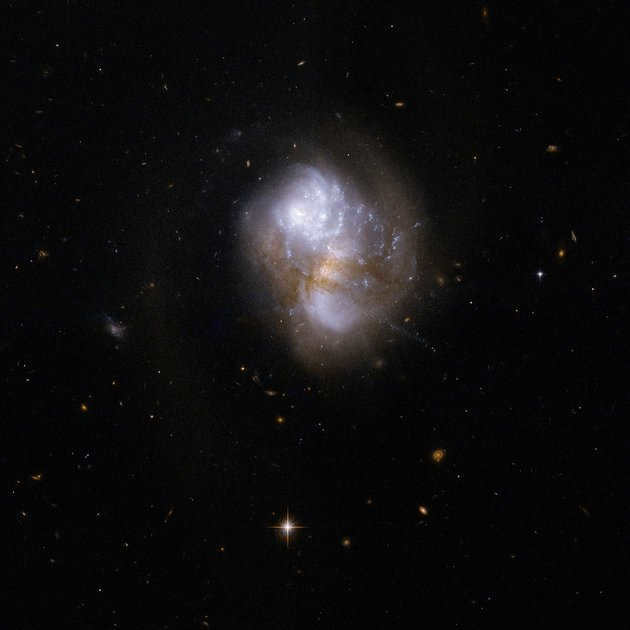
This particular set of galaxies, also referred to as Arp 236, ESO 541-23, and IRAS 01053-1746, was first observed by American astronomer Lewis Swift on November 19, 1897. One of the galaxies in the IC 1623 system contains a notable amount of warm and dense gas. This same gas can also be found in the area where the two galaxies overlap. The pair is currently in the process of merging, and it is expected that a strong influx of gas towards the center will trigger a burst of intense star formation, potentially causing the infrared luminosity to exceed the superluminal threshold.
The IC 1623 system is situated in the Kita constellation and is estimated to be approximately 269 million light-years away.
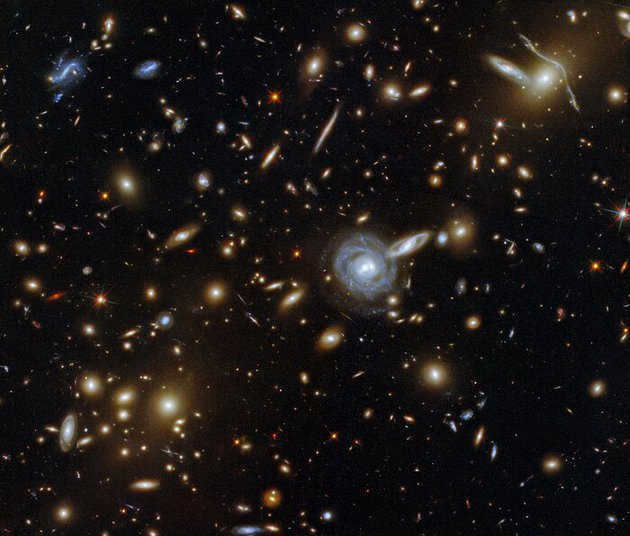
The photo depicts the ACO S 295 system, an enormous group of galaxies situated approximately 3.5 billion light-years away in the small southern constellation of Clock.
Clusters of galaxies encompass countless galaxies of various ages, shapes, and sizes. Their mass is typically about a quadrillion times that of the Sun. At one time, they were considered the largest constructs in the Universe until superclusters, or galaxy clusters, were discovered in the 1980s. However, since clusters are held together by gravity, they still hold the title of the largest structures in the Universe bound by gravity.
According to the general theory of relativity proposed by Albert Einstein, it was predicted that massive objects would cause a distortion in the fabric of space itself. When light passes through one of these objects, such as a massive cluster of galaxies, its path is slightly altered. This phenomenon, known as gravitational lensing, is quite rare and can only be observed using the most advanced telescopes. Hubble, being one of the best telescopes, is capable of capturing the phenomena associated with gravitational lensing.
The space telescope’s website states, “Aside from its impressive size, this collection of galaxies also exhibits various orientations. Spiral galaxies, like the one featured in the center of this image, are positioned to face us, while other galaxies appear as thin streaks of light when viewed from their edges.”
Messier 61 Galaxy.
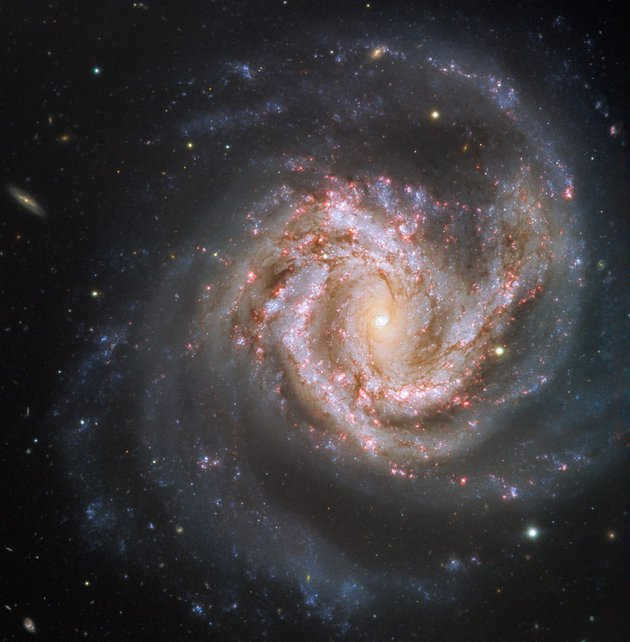
This composite image showcases the Messier 61 spiral galaxy, also known as M61, NGC 4303, LEDA 40001, and IRAS 12194 + 0444. Situated in the constellation Virgo, this celestial body is located at a distance of 52.5 million light-years from Earth. Barnaba Oriani, an Italian astronomer, discovered this galaxy on May 5, 1779, whereas French astronomer Charles Messier initially mistook it for a passing comet.
Spanning approximately 100,000 light-years in diameter, the Messier 61 galaxy is comparable in size to our very own Milky Way. It is a prominent member of the Virgo cluster, a massive group of galaxies. Researchers believe that the luminous regions within this galaxy indicate a burst of star formation.
A vast expanse of stars spanning a distance of 200,000 light-years
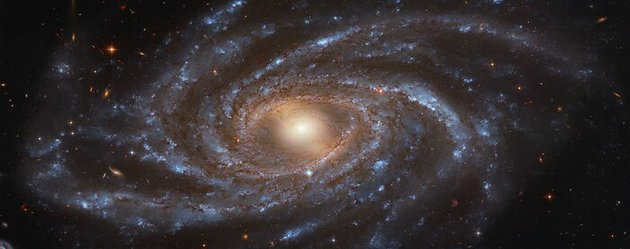
Stretching across a distance of 200,000 light years, the galaxy NGC 2336 falls into the category of spiral galaxies with a junction. What sets this galaxy apart is the dazzling spiral arms adorned with young stars that emit a vibrant blue glow.
Back in 1876, German astronomer Wilhelm Tempel spotted NGC 2336 using a 28-centimeter telescope. Nearly a century later, in 1987, the galaxy witnessed a Type Ia supernova, which remains the only observed supernova occurrence since its initial discovery 111 years earlier.
The Beauty of a Sculptor
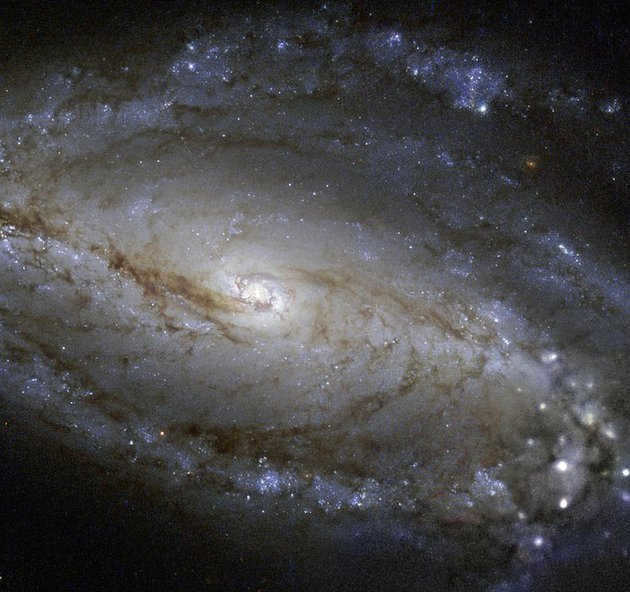
NGC 613, located in the Sculptor constellation, is a spiral galaxy that is situated 67 million light-years away from our planet.
Similar to many other spiral galaxies, including our own Milky Way, NGC 613 possesses a central hub. The Hubble photo displays this hub at its core, with elongated “arms” curving around the adjacent bulge.
William Herschel, the renowned Anglo-German astronomer, discovered NGC 613 in 1798.
The Hubble Space Telescope was launched on April 24, 1990, and has been supplying astronomers with priceless data for over three decades. Although the Hubble program was officially extended until June 30, 2021, on June 23, 2016, it is still operational today.
The Hubble Space Telescope has recently released a fresh image that depicts the union of three galaxies, following a period of concern about the future of the renowned observatory.
advertisement
Hubble is now fully operational again after a series of significant technical issues.
The latest image from the Hubble Space Telescope showcases the merging of three galaxies, which occurred shortly after scientists expressed their worries about the potential shutdown of this iconic observatory.
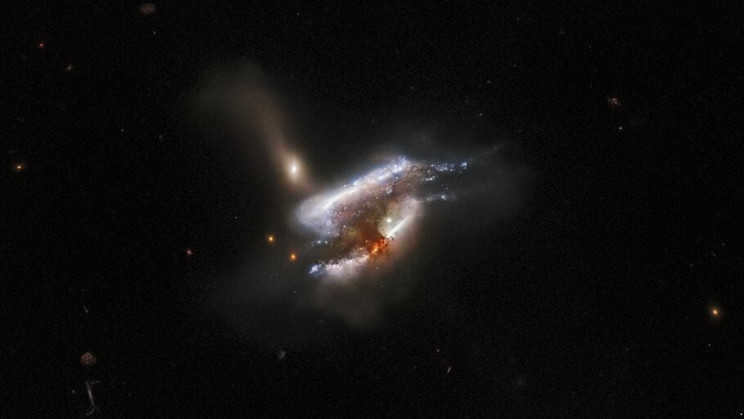
A collision involving three galaxies has been captured in a stunning new image by the Hubble Space Telescope. The image, taken by the European Space Agency’s Hubble, shows a cosmic object known as IC 2431, which is located a staggering 681 million light-years away from Earth. Despite appearing as a single galaxy at first glance, IC 2431 is actually the result of three separate galaxies merging together in a monumental cosmic event. This merger will eventually lead to the formation of one massive galaxy, as stated in a press release.
Studying the collisions of galaxies provides valuable insights into the effects of such events on the interconnected celestial bodies within them. This is particularly relevant for understanding the potential fate of our own galaxy, the Milky Way. According to a study conducted in 2019, astronomers have suggested that in millions of years, the Milky Way may be engulfed by its closest neighbor, Andromeda. Furthermore, evidence exists that the Milky Way has previously absorbed other galaxies, leaving behind remnants of these cosmic acts of cannibalism.
The formation of our Universe is attributed to galactic mergers.
The most common type of galactic collisions are binary galactic mergers, although astronomers have also documented several instances of triple mergers. Scientists predict that the black holes located at the center of each galaxy will eventually combine to create an enormous supermassive black hole. However, no direct observation of this phenomenon has been made thus far. In a recent study conducted by astronomers from the University of Colorado at Boulder, it was proposed that the distorted shape of the Andromeda galaxy is the result of a collision between two black holes, resulting in a significant “gravitational shock”.
Rebecca Taylor’s summer marshmallow – bump dress is a must-have for the season. You can find this beautiful dress at http://kniti.ru, where it was knitted with precision.
Elena Zavgorodnyaya has created a fascinating cartoon series featuring vampires that is sure to captivate audiences.
Discover the exquisite Jewels of the House of Romanov, including the stunning dowry of V. prn. Anna Pavlovna. One of the notable pieces is the Jean Baptiste van der Hulst Portrait.
If you’re a fan of spooky places, you don’t want to miss out on visiting the Church of St. Jiří in the Czech village of Lukova. This eerie church has a history dating back to the 11th century and is known as one of the 10 scariest places in the world!
–Music
–Photo album
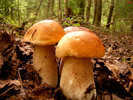 Taiga 00:17 03.08.2014 Photos: 20
Taiga 00:17 03.08.2014 Photos: 20  Flowers 14:18 27.02.2014 Photos: 20
Flowers 14:18 27.02.2014 Photos: 20  Fantastic 00:31 21.10.2013 Photos: 20
Fantastic 00:31 21.10.2013 Photos: 20
–Always within reach
–Find through journal
–Receive updates by email
–Companions
–Regular followers
–Analytics

At great distances, gravity exerts a powerful influence on stellar systems, resulting in the surprising and unusual shapes of interacting galaxies.

Arguably the most famous duo of interacting galaxies are the Antennas (NGC4038 and NGC4039). Two expansive spiral star systems, comparable in magnitude to the Milky Way, commenced their interaction several hundred million years ago. The gravitational forces drastically altered their paths, resulting in a collision between the galaxies. The aftermath of this monumental cosmic catastrophe is captured in the stunning Hubble photograph: dust and luminous hydrogen clouds are scattered throughout, the spiral arms have virtually vanished, and numerous stars, evident in the image as a hazy glow, have been expelled from the galaxies. Photo credit: NASA, ESA, and the Hubble Heritage Team (STScI/AURA)-ESA/Hubble Collaboration
A classic depiction of galaxies interacting can be seen in this image. The gravitational force exerted by NGC 2937, the elliptical star system located at the bottom of the photograph, has disrupted the once-perfect spiral of NGC 2936. NGC 2937 is currently attracting stars, dust, and gas from NGC 2936, but it will take millions of years for them to fully merge. Astronomers, known for their sense of humor, humorously liken the galaxies to a female penguin hunched over her egg. Image credit: NASA, ESA, and the Hubble Heritage Team (STScI/AURA)
A duo of Mouse galaxies that are interacting with each other was initially described by B. Vorontsov-Vel’yaminov, a Soviet astronomer. In 1959, he released an atlas and a catalog of interacting galaxies, which included 354 other objects in addition to the pair of Mouse galaxies. The noteworthy feature of this pair is the presence of long tidal tails that have been formed from the spirals of these galaxies. Vorontsov-Vel’yaminov demonstrated, even in the absence of high-resolution digital images, that these tails are composed of stars. Photo: NASA, H. Ford (JHU), G. Illingworth (UCSC/LO), M. Clampin (STScI), G. Hartig (STScI), the ACS Science Team, and ESA
A remarkable display of celestial activity is captured in this image from the Hubble Telescope. Multiple galaxies can be seen interacting and exchanging matter in a mesmerizing dance. One particularly awe-inspiring feature is the spectacular fountain of stars, gas, and dust that stretches over an incredible distance of 100,000 light-years. Dotted throughout this cosmic spectacle are clusters of brilliant blue stars, which were born as a direct result of the collision of galaxies and the compression of gas within them. This stunning group of galaxies has been designated as Arp 194 in the catalog of peculiar galaxies compiled by astronomer Halton Arp. The image, captured by NASA, ESA, and the Hubble Heritage Team (STScI/AURA), serves as a testament to the awe-inspiring wonders of the universe.
There is an interesting characteristic of astronomical images: due to the vast distances to objects in space, they all appear to be situated at the same distance from us. The depicted image showcases a captivating collision between galaxies, one of which is a spiral galaxy and the other, larger and more “loose”, is an irregular galaxy. However, upon closer examination, it becomes apparent that the spiral galaxy is actually much farther away than the irregular galaxy ESO 489-056, with an estimated distance of 15 million light-years. In reality, a distant spiral galaxy is colliding with its neighboring spiral galaxy! Photo: ESA/Hubble & NASA/Luca Limatola
NGC 6670 represents a stunning duo of interacting galaxies that can be observed from the edge. Scientists hypothesize that these galaxies have already undergone a close encounter and the observed formation indicates the early phase of a second merging event. The distance to this extraordinary pair is estimated to be approximately 400 million light years. Image credit: NASA, ESA, the Hubble Heritage Team (STScI/AURA)-ESA/Hubble Collaboration and A. Evans (University of Virginia, Charlottesville/NRAO/Stony Brook University)
Following the collision, the Arp 148 duo, consisting of two spiral galaxies, underwent a direct collision several tens of millions of years ago. Consequently, the galaxy that is visible to us head-on transformed into a ring shape without a central nucleus, while the other galaxy was influenced by tidal forces. Situated 500 million light-years away from Earth in the Big Dipper constellation, Arp 148 is captured in this image taken by NASA, ESA, and the Hubble Heritage Team (STScI/AURA).
Similar to ice skaters, the two galaxies engage in a graceful waltz as they are pulled together by the force of gravity, causing them to lose some of their matter. A colossal bridge composed of stars, gas, and dust has formed between the neighboring galaxies, while their outer regions have been transformed into curved tidal tails. These galaxies, known as UGC 8335 (or Arp 238), reside in the constellation of the Big Dipper and are situated approximately 400 million light-years away from our planet. Image credit: NASA, ESA, the Hubble Heritage Team (STScI/AURA)-ESA/Hubble Collaboration and A. Evans (University of Virginia, Charlottesville/NRAO/Stony Brook University)
Arp 87 is a prime illustration of galaxies interacting. The larger galaxy, NGC 3808, is transferring dust, gas, and stars to its companion, resulting in the formation of a massive arm. The gravitational forces between the two galaxies have distorted their shapes. The Arp 87 pair can be found in the Leo constellation, approximately 300 million light-years away from Earth. Photo: NASA, ESA, and The Hubble Heritage Team (STScI/AURA)
Astronomers have discovered an interesting celestial phenomenon in the Giraffe constellation. IC 2184, a pair of galaxies, is caught in a gravitational dance. These galaxies, which are about half the size of our Milky Way, are located approximately 160 million light-years away from Earth. The peculiar thing about IC 2184 is that it resembles the letter V in its appearance.
Studying these interacting galaxies is quite challenging for scientists. Due to their gravitational interaction, their shapes have become highly distorted. They now have tidal tails made up of gas and stars. In addition, there are regions of intense star formation, where clusters of stars can be observed.
Despite their unusual appearance, it is difficult to determine the exact type of these galaxies. However, astronomers speculate that they may be spiral galaxies, but observed from an edge-on perspective. This means that we are looking at them from the side, rather than face-on.
This remarkable image of IC 2184 was captured by Serge Meunier, using the ESA/Hubble & NASA telescope. It offers a fascinating glimpse into the vastness of our universe and the incredible phenomena that occur within it.
NGC 6872/IC 4970, a pair of galaxies, can be found in the Peacock constellation and is situated approximately 200 million light years away. NGC 6872, classified as a giant spiral galaxy of the SBb type, exhibits a distinct junction. On the other hand, the smaller IC 4970 galaxy, positioned above the center of NGC 6872, falls under the category of lenticular galaxies. Adjacent to the galaxies, there is a prominent star shining brightly. It is noteworthy that the upper arm of NGC 6872 shows significant deformation due to the presence of clusters of vibrant blue stars. This phenomenon is a result of the ongoing star formation process, characterized by explosive activity, within the galaxy. Photo credit: ESO
NGC 5331 is a pair of galaxies that are interacting with each other in the Virgo constellation. The image clearly displays faint tidal tails that extend far away from the galaxies. What’s interesting is that NGC 5331 is exceptionally bright in infrared light, hundreds of billions of times brighter than the Sun. This indicates that there has been a burst of star formation within the interacting galaxies. The estimated distance to NGC 5331 is about 450 million light years. Photo credit: NASA, ESA, the Hubble Heritage Team (STScI/AURA)-ESA/Hubble Collaboration and A. Evans (University of Virginia, Charlottesville/NRAO/Stony Brook University)
NGC 520 is another pair of spiral galaxies that have collided in the Pisces constellation. It is located approximately 90 million light-years away from Earth. This collision has resulted in the formation of a tadpole-shaped structure with a long tail composed of stars. Photo credit: Mount Lemmon Sky Center
Two spiral galaxies, NGC 6050 and IC 1179, which belong to a group of galaxies in the Hercules constellation, have already experienced a collision of their spiral arms. In the next few million years, it is expected that their central regions will come dangerously close to each other. The Arp 272 pair is located about 450 million light-years away from Earth, also in the Hercules constellation. The Hercules galaxy cluster is a part of the Great Wall, an enormous supergroup of galaxies that is considered to be the largest structure in the entire Universe. The stunning photo was captured by NASA, ESA, the Hubble Heritage Team (STScI/AURA)-ESA/Hubble Collaboration, and K. Noll (STScI).
The spiral galaxy NGC 7714 is situated at a distance of 100 million light-years from our planet Earth – a relatively nearby location when considering the vastness of the Universe. In the not-so-distant past, NGC 7714 underwent the gravitational impact caused by its smaller companion, NGC 7715, which has since been left behind. As a consequence of this interaction, NGC 7714 has acquired peculiarly-shaped arms and a radiant golden haze, consisting of stars that were forcefully ripped away from its core. It is highly probable that these galaxies will merge together into a single entity in the future. Photo: ESA/Hubble & NASA
Is this object two galaxies or one? It’s a difficult question to answer due to the unusual shape of the image, which was discovered by Soviet astronomer B. A. Vorontsov-Vel’yaminov in the 1950s. The image actually depicts two galaxies that are interacting so closely that one has almost completely transformed into a tidal tail. The galactic nuclei have become highly deformed and are only 16,000 light-years apart, making it likely that they will eventually merge into a single large nucleus. Known as VV 705 (also listed as No. 848 in the Veniamin Markarian catalog), this pair is located 550 million light-years away from Earth in the Volopasa constellation. Photo credit: NASA, ESA, the Hubble Heritage Team (STScI/AURA)-ESA/Hubble Collaboration and A. Evans (University of Virginia, Charlottesville/NRAO/Stony Brook University)
This photograph captures the merging of two galaxies. As a lens-shaped galaxy passes through a spiral galaxy, it creates an intriguing and asymmetrical pattern. The collision site is highlighted by a bright trail of stars that extends upwards, immediately drawing attention. Adjacent to the star trail, there is a large and hazy spot, which astronomers believe to be a remnant of the spiral galaxy’s core. This core was forcefully expelled from the system and partially dispersed during the collision. If this interpretation is accurate, then this image is truly one of a kind. Situated 300 million light-years away from Earth, the ESO 576-69 galaxies are the subjects of this photo. Photo credit: ESA/Hubble & NASA/Luca Limatola
The side view of the ESO 69-6 galaxies resembles musical notes, creating a mesmerizing dance in silence. This ethereal quality is attributed to the elongated tidal tails composed of stars and interstellar gas, spanning distances of hundreds of thousands of light-years! The presence of these tails serves as a distinctive feature of interacting galaxies. Located in the Southern Triangle constellation, the ESO 69-6 galaxy pair resides approximately 650 million light-years away from Earth. Photo: NASA, ESA, the Hubble Heritage Team (STScI/AURA)-ESA/Hubble Collaboration and A. Evans (University of Virginia, Charlottesville/NRAO/Stony Brook University). Evans (University of Virginia, Charlottesville/NRAO/Stony Brook University) 

